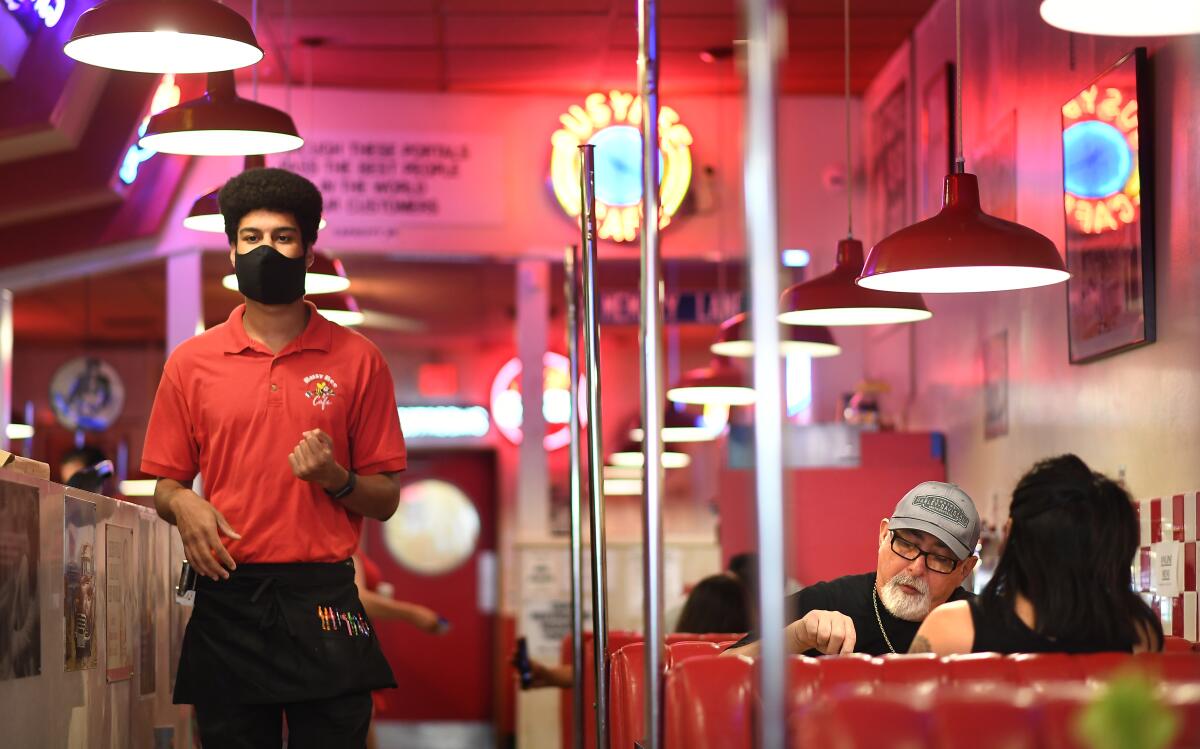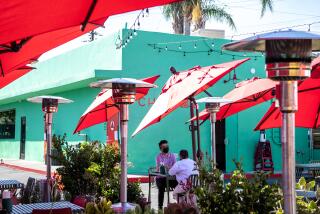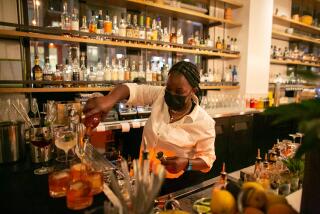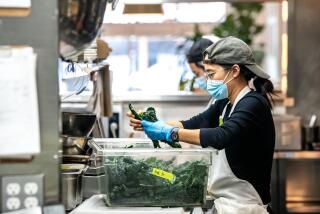Finally allowed to reopen their dining rooms, L.A. chefs say, ‘Not so fast’

- Share via
After more than 10 weeks, restaurants in Los Angeles County were abruptly greenlit to restart dine-in service on Friday. But many owners and chefs say it’s just too soon to throw open their doors.
They cite substantial challenges to getting fully up and running again: dining rooms that have yet to be properly reconfigured, safety concerns, furloughed employees wary about returning to work, uncertainty about whether diners will show up and fears about a spike in COVID-19 infections that could result in another crippling shutdown.
“It’s irresponsible of the county to drop this on everyone and not have concise guidelines on how we are supposed to keep everyone safe,” said Ari Kolender, chef and co-owner of Found Oyster in East Hollywood.
“Our timeline is going to be more in line with how we combat the disease instead of what the city says is OK,” said Jon Yao, chef-owner of Kato in West L.A. “I’m just scared. I thought it was going to be, like, next year or something.”
That means for many of the region’s most popular restaurants — Alimento, n/naka, Ronan, Birdie G’s, Cassia, Lawry’s the Prime Rib and Sonoratown among them — takeout will remain the status quo for a while.
Calling the latest developments “head-spinning,” Bar Amá chef-owner Josef Centeno said on Instagram: “Order online if you need a bottled margarita. I know I do.”
Friday’s whiplash announcement gave restaurants the go-ahead to reopen, provided they can meet the county’s guidelines and safety protocols.
But in a reflection of the helter-skelter patchwork of city, county and state rules issued since the shutdown began in mid-March, actual guidelines weren’t released right away. Los Angeles County Supervisor Kathryn Barger said specifics would be announced Tuesday, while Public Health Director Barbara Ferrer said county protocols “will be posted very shortly.”
Meanwhile, Mayor Eric Garcetti said at a late-afternoon news conference that restaurants may reopen starting Friday. He stressed that restaurants should prioritize outdoor seating and curbside pickup, that bar areas must remain closed and that occupancy must be limited to 60%.
Garcetti also encouraged owners to download a newly released document that includes suggested guidelines and a safety checklist. It includes recommendations for physical distancing, cleaning and sanitizing, employee health and support, personal hygiene and facility safety.
“Businesses are not mandated to open,” he said. “Take your time to get it right.”
But the time to “get it right” does not square with the financial pressures that restaurant owners and workers face. And the government, at all levels, has done little to signal that restaurants can expect much in the way of meaningful relief to help them recover.
My staff for sure does not feel comfortable with reopening the dining room. Our team would be handling dishes that were obviously touched. It’s hard to ask them to put their lives at risk that way.
— Lien Ta, managing partner of Here’s Looking at You and All Day Baby
Lien Ta of Here’s Looking at You in Koreatown and All Day Baby in Silver Lake said that even if both her restaurants came back at 100% capacity tomorrow, it wouldn’t be enough to dig them out of the financial crater blown open over the last two and half months. She’s waiting for news on the proposed $120-billion restaurant stabilization fund that the federal government could use to distribute money.
“Even if we do things like takeout and reopen, the truth is we still need more funding,” she said.

One of L.A.’s most well-known food halls will be among the first to welcome diners again: “Dine-in seating at Grand Central Market is back! We’re ready,” said its post on Instagram. Masks will be required to enter the historic downtown market, and customers will have to maintain six feet of distance from one another and walk one-way only through the aisles.
One of the key hurdles to clear in reopening is addressing the comfort levels of would-be diners.
“I can’t talk my wife into going out to eat, no way,” said Jon Shook, who owns several L.A. restaurants, including Animal and Son of a Gun, with Vinny Dotolo. “Vinny and me have been out on the front lines, so to speak, bringing meals to people in need, but even I can’t say I’m going to feel 100% safe and comfortable sitting down to eat with my mask off.”
Restaurant workers, too, are worried about their safety.
“My staff for sure does not feel comfortable with reopening the dining room,” Ta said. “Our team would be handling dishes that were obviously touched. It’s hard to ask them to put their lives at risk that way.”
Some are forging ahead because they feel they have no other choice. Chef-owner Josiah Citrin said he will reopen Charcoal Venice on Thursday partly because the money he received from the federal Paycheck Protection Program loan is almost gone.
Citrin figures going to a restaurant is safer than shopping at a crowded grocery store and believes diners will return after being cooped up for so long.
“For now, what else can you do?” he said. “You can’t go to a movie, you can’t go to a concert, you can’t go to a sporting game, so restaurants will be in pretty high demand.”
Many restaurants will throw their doors open because they need it.
— Kat Turner, chef of Highly Likely
Armando De La Torre Jr., owner of the Guisados chain of taquerias, was optimistic. “We’ve been sitting with our hands tied behind our back for two months,” he said. “Now it feels like at least we have one hand free.”
De La Torre said outdoor seating would resume immediately, but he would be cautious at locations where only indoor seating is available. He doesn’t feel the health and safety guidelines will be significantly different from what his employees were observing while serving takeout.
“It’ll be a gradual process getting customers to come back, but we have to start somewhere,” he said. “If each week is better than the last, eventually that will get us back to where we need to be.”
The specter of another spike in COVID-19 cases and the potential for another forced closure looms large over the potential relief of reopening, and restaurateurs say they need to weigh that possibility against the very real need to make money.
“Many restaurants will throw their doors open because they need it,” said chef Kat Turner of Highly Likely in West Adams. Owners have been “hemorrhaging money,” she said, but “the idea of bringing back team members who’ve been laid off, just to be laid off again, is brutal.”
“It’s a gargantuan and expensive effort to open and close and open and close,” said Zach Pollack, who reopened Alimento, his Silver Lake Italian restaurant, for takeout a week ago.
“You just stocked up on $20,000 to $30,000 in inventory, a big chunk of that is perishable and then you suddenly have to close? All that money goes down the drain.”
Pollack said it makes sense for retail stores to allow customers inside again but called the reopening of restaurants premature.
“There is a lot of pressure on these governors and mayors who, if we had different leadership and if other states weren’t aggressively trying to reopen, wouldn’t be trying to do so as quickly,” he said.
Getting the all-clear from the government is one thing. Shook said he also wants leadership by example.
“I hope that elected officials go out and eat at and support independent restaurants to show that it’s safe,” he said. “There’s a lot of healing that needs to happen before people are going to be comfortable eating in dining rooms around people they don’t know again.”
Times staff writers Genevieve Ko, Ben Mims and Garrett Snyder contributed to this report.
More to Read
Eat your way across L.A.
Get our weekly Tasting Notes newsletter for reviews, news and more.
You may occasionally receive promotional content from the Los Angeles Times.












